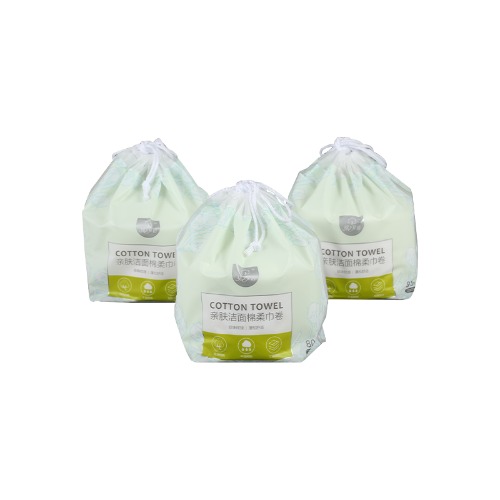News
Home / News / Industry News / The Classification of Personal Care Cotton and The production steps of Personal Care Cotton
News
The Classification of Personal Care Cotton and The production steps of Personal Care Cotton
Personal care cotton, commonly known as cotton pads or cotton balls, can be classified based on various factors. Here are some common classifications of personal care cotton:
Composition:
100% Cotton: Personal care cotton made entirely from natural cotton fibers without any synthetic additives or blends.
Blended Cotton: Personal care cotton that combines cotton fibers with other materials, such as rayon or polyester. Blended cotton pads may offer enhanced absorbency or other specific properties.
Shape and Size:
Round Cotton Pads: Circular-shaped cotton pads, often used for makeup removal, applying toners, or general skincare purposes.
Square Cotton Pads: Square-shaped cotton pads that provide larger surface area for makeup removal, nail polish removal, or applying skincare products.
Cotton Balls: Loosely formed balls of cotton used for a variety of personal care applications, such as applying creams or lotions, removing makeup, or gentle cleansing.
Thickness and Density:
Thin Cotton Pads: Lightweight and thin cotton pads suitable for gentle and precise application of skincare products or makeup removal.
Thick Cotton Pads: More substantial and thicker cotton pads that offer greater absorbency and durability. They are often used for removing stubborn makeup or applying toners.
Specialty Cotton Pads:
Organic Cotton Pads: Personal care cotton made from organic cotton fibers grown without the use of pesticides or chemical fertilizers.
Exfoliating Cotton Pads: Cotton pads with a textured surface designed for gentle exfoliation of the skin during cleansing.
Lint-Free Cotton Pads: Cotton pads specially designed to minimize lint and fiber shedding during use, making them ideal for makeup application or nail care.
Packaging:
Bulk Packaging: Personal care cotton sold in larger quantities, such as rolls, packs, or boxes, suitable for professional use or frequent personal use.
Travel-Sized Packaging: Compact and portable packaging options, such as small resealable bags or travel-friendly containers, suitable for on-the-go or travel purposes.
These classifications are not exhaustive, and variations may exist based on different manufacturers and specific product lines. Additionally, personal care cotton products may come with additional features or attributes, such as hypoallergenic properties, extra softness, or specific certifications.
When choosing personal care cotton, consider factors like your intended use, preferred shape or size, desired level of absorbency, and any specific preferences for organic or specialty options.Meanwhile,The production of personal care cotton involves several steps to transform raw cotton fibers into the finished cotton pads or cotton balls. Here is a general overview of the production steps involved:
Raw Material Preparation:
Cotton fibers are harvested from cotton plants.
The harvested cotton undergoes a cleaning process to remove impurities, such as leaves, seeds, and dirt.
Carding:
The cleaned cotton fibers are carded, which involves combing and aligning the fibers to create a uniform web.
Carding helps remove any remaining impurities, align the fibers, and prepare them for the next step.
Formation of Cotton Pads or Balls:
The carded cotton fibers are formed into the desired shape, either as flat cotton pads or round cotton balls.
For cotton pads, the fibers are layered and pressed together to create thin sheets. These sheets are then cut into the desired shape and size.
For cotton balls, the fibers are loosely formed into round shapes and compressed to create denser balls.
Sterilization and Sanitization:
To ensure hygiene and safety, the cotton pads or balls may undergo sterilization or sanitization processes.
This can include treatments such as heat sterilization, chemical sanitization, or exposure to ultraviolet (UV) light.
Quality Control and Inspection:
Throughout the production process, quality control measures are implemented to ensure that the cotton pads or balls meet the required standards.
Inspections may include checking for uniform thickness, proper shape, absence of impurities, and overall quality of the finished products.
Any defects or issues are identified and corrected to maintain the quality of the personal care cotton.
Packaging and Distribution:
The finished cotton pads or balls are packed into appropriate packaging, which can include plastic bags, boxes, or resealable containers.
Packaging may also include labeling, branding, and instructions for use.
The packaged personal care cotton products are then prepared for distribution and shipped to retailers or customers.
It's important to note that the specific production steps may vary depending on the manufacturer and the type of personal care cotton being produced. Some manufacturers may also incorporate additional processes, such as bleaching or adding special finishes to enhance the softness or absorption properties of the cotton pads or balls.
Furthermore, manufacturers must adhere to relevant regulations and guidelines to ensure the safety and quality of the personal care cotton products, particularly those intended for direct contact with the skin or use in sensitive areas.





 中文简体
中文简体 русский
русский Português
Português Español
Español









